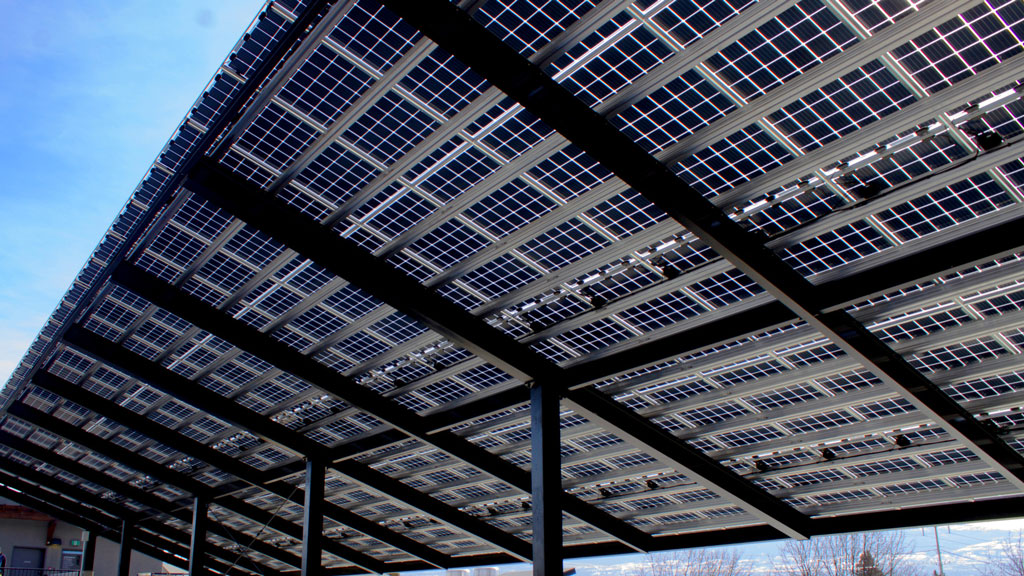Strides are being made in new solar technology that can be integrated into building planning, design and construction with more hardware and concepts transferred to Canada from the U.S. and Europe.
New solar technologies emerging are solar roof tiles, integrated building photovoltaics (BIPV), while still looming on the horizon are concepts such as turning reservoirs into energy farms with floating solar cells and housing complexes in a co-op sharing an installation.
“It (solar) is definitely becoming more mainstream,” said Landon Aldridge, vice-president of operations for SkyFire Energy Inc., as more residential, commercial, and institutional construction is adopting solar.
SkyFire, with offices in Penticton, Edmonton and Calgary, and Regina, has 2,700 installations including large scale utility installations such as B.C.’s first, SunMine at Kimberley, and is now working on two others: one a 33 MW development and a second 6.6 MW project in Alberta. It has also installed solar on 45 schools excluding universities and colleges in the three provinces.
Solar roof tiles and BIPV are the new frontiers. BIPV is currently one of the fastest growing global markets according to Natural Resources Canada but still remains a niche market in Canada with more than 50 buildings using some aspect of it.
There are three main areas where solar technology can be integrated into the building. They are on the roof (shingles, tiles and skylights), facades (cladding, curtain walls and windows) and external integrated systems (balcony railings and shading systems). The BIPV products on the market use either crystalline silicon-based solar cells or thin film technologies.
SkyFire Energy has completed approximately eight BIPV installations in Western Canada, said Aldridge, and structures include Telus Garden, the Okanagan College Health Science Building, the University of Alberta PAW building, the EPCOR North Service Centre and a solar awning system at Edmonton’s Landmark Group building. To optimize the benefits, he said, installers need to be brought in during the design stage to work with the architect and identify areas on a building that best work.
Pushing the growth of solar, whether it is panels or solar used in integrated design, are advances in battery storage capacity. Tesla, the U.S. company spearing automotive change, is also at the forefront of introducing storage capacity both for large utility projects as well as homeowners.
Vancouver Solar & Electrical (VSE), which does both commercial and residential installations of solar, is one of a number of companies that also supplies, installs and services Tesla’s Powerwall 2.0 rechargeable storage battery and installs Tesla’s electric vehicle chargers.
Managing director and owner Tarum Lloyd said the $5,000 federal grant now offered to homeowners plus the ability to sell surplus energy into BC Hydro’s grid is spurring the development of the B.C. home market. The homeowner can draw on the Powerwall’s stored capacity during the evenings or peak periods and reduce energy consumption from the energy grid.
“The grid can become your back-up system rather than Powerwall,” he said.
Solar roof tiles by Tesla are expected to land in Canada before year end but onto the market by mid 2022, installers say.
SkyFire is one company that will be offering them, but not before running some trials in 2021.
Solar tiles have entered the Canadian market previously, but incurred difficulties and installers pulled away. Tesla’s product, which has been five years in development and struggled through its own difficulties, is currently being installed in the U.S.
In July, Tesla announced it was installing its V3 solar roof tiles and its Powerwall 2 battery storage in phases in the SunHouse, a new-build Austin, Texas sustainable community. The tiles, according to Tesla’s website, carry a Class A fire rating (in the U.S.) and a U.S. warranty of 25 years.
Integrating solar into whole housing developments is another emerging market. Solar virtual net metering works like a co-op with each member buying into the solar utility and obtaining a portion of their energy from the installation. Aldridge said these systems work well for individuals who rent or who do not have building space to mount panels.
In multiple residential complexes, the electricity generated can be integrated into the operations of the buildings.
“It is not going to each suite but the elevator or site lighting or maybe the pool,” he said.
The traditional solar panel, still the mainstay of the industry, has itself evolved.
Rikur Energy’s Kol Henrikson said there has been a significant increase in the efficiency of the standard solar panel.
“The cells are becoming energy dense,” he said and wattage capacity has increased over the past six years. A panel that once produced 250 watts can provide 350 to 360 watts, while the commercial range has jumped from 300 watts to as much as 600 watts.
At the same time, labour and panel costs have dropped to almost half their cost, reducing the payback periods.
“It’s now a 10-year pay back,” said Henrikson.
Henrikson sees factors on all fronts driving solar.
While Site C’s massive buildout cost will make electricity more expensive, he believes, climate change is moving away from fossil fuels and BC Hydro’s net metering system is allowing extra power to be returned to the grid for credit. The move to electric vehicles is leading to more vehicle chargers in buildings. It’s all good for business, he said, as his company now bids on retrofitting a firehall.
BC Hydro has approximately 3,800 residential and commercial customers participating in its net metering program, with the majority using solar producers for a total of 29 megawatts of installed solar photovoltaic capacity on the utility’s grid.
Canada still remains at the early stages of using photovoltaics.
Other countries have made bolder moves to explore applications. Floating solar installations are being used in South Africa and consist of a layer of cells moored over a reservoir.
“There are a lot of opportunities,” said Aldridge.










Recent Comments